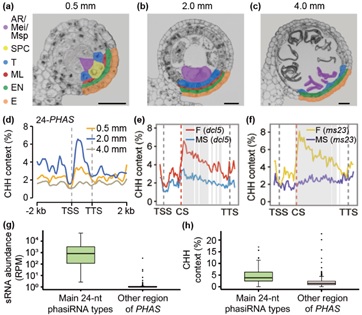Researchers led by Dr. ZHANG Mei from the Institute of Botany of the Chinese Academy of Sciences reported 24-nt phasiRNA contributing to the increased CHH DNA methylation at 24-PHAS in maize meiotic anthers, related results were recently published on New Phytologist.
Phased secondary small interfering RNAs (phasiRNAs) constitute a major category of small RNAs, functioning as key regulators during plants growth, development and reproduction. Two types of phasiRNAs exists in maize--21-nt phasiRNAs and 24-nt phasiRNAs. Previous studies have shown that dcl5-1 mutants, which are deficient in 24-nt phasiRNAs, exhibit conditional male fertility, with the main defect in tapetal cell differentiation during meiosis. Furthermore, elevated CHH DNA methylation at PHAS loci (phasiRNA precursor) in zygotene stage maize meiocytes and in whole anthers compared to levels in seedlings. However, how 24-nt phasiRNAs function in plants is still poorly addressed.
Based on previous studies, Dr. Zhang’s team and their collaborators utilize two maize male-sterile mutants -- ms23 (no 24-nt phasiRNAs) and dcl5 mutants (a few 24-nt phasiRNAs) -- to further investigate whether the 24-PHAS loci acquire elevated CHH DNA methylation after synthesis of the 24-nt phasiRNAs or not.
Researchers found CHH DNA methylation of most 24-PHAS loci is increased in meiotic anthers of the control plants but not in the ms23 or dcl5 mutants. Since 24-PHAS transcripts exist in dcl5 mutants but not ms23, they concluded that 24-nt phasiRNAs, rather than PHAS transcription, are required for targeting increased CHH methylation at these loci.
Further they found that the meiotic stage has a relatively high CHH methylation level compared to pre-meiotic stage in the control plants. Additionally, only one or a few types of 24-nt phasiRNA(s) from individual 24-PHAS are highly accumulated, although PHAS precursors are processed into multiple 24-nt siRNA products. And their positions in the genome corresponded to high CHH methylation.
These results demonstrated that CHH DNA methylation levels are developmentally regulated, being highest in 2.0 mm, mid-meiosis anthers compared to earlier or later stages, and demonstrated that 24-nt phasiRNAs are competent to direct CHH DNA methylation in cis.
This work was supported by Starting Funding of the Chinese Academy of Sciences, U.S. National Science Foundation Plant Genome Research Program and the International Postdoctoral Exchange Fellowship Program etc.

24-nt phasiRNAs, as cis elements, contribute to increased CHH methylation in 24-PHAS
Articlelink: https://doi.org/10.1111/nph.17060
CONTAC INFO:
Institute of Botany, Chinese Academy of Sciences,
20 Nanxincun, Xiangshan, Beijing 100093, China
E-mail: mei.zhang@ibcas.ac.cn
Researchers led by Dr. ZHANG Mei from the Institute of Botany of the Chinese Academy of Sciences reported 24-nt phasiRNA contributing to the increased CHH DNA methylation at 24-PHAS in maize meiotic anthers, related results were recently published on New Phytologist.
Phased secondary small interfering RNAs (phasiRNAs) constitute a major category of small RNAs, functioning as key regulators during plants growth, development and reproduction. Two types of phasiRNAs exists in maize--21-nt phasiRNAs and 24-nt phasiRNAs. Previous studies have shown that dcl5-1 mutants, which are deficient in 24-nt phasiRNAs, exhibit conditional male fertility, with the main defect in tapetal cell differentiation during meiosis. Furthermore, elevated CHH DNA methylation at PHAS loci (phasiRNA precursor) in zygotene stage maize meiocytes and in whole anthers compared to levels in seedlings. However, how 24-nt phasiRNAs function in plants is still poorly addressed.
Based on previous studies, Dr. Zhang’s team and their collaborators utilize two maize male-sterile mutants -- ms23 (no 24-nt phasiRNAs) and dcl5 mutants (a few 24-nt phasiRNAs) -- to further investigate whether the 24-PHAS loci acquire elevated CHH DNA methylation after synthesis of the 24-nt phasiRNAs or not.
Researchers found CHH DNA methylation of most 24-PHAS loci is increased in meiotic anthers of the control plants but not in the ms23 or dcl5 mutants. Since 24-PHAS transcripts exist in dcl5 mutants but not ms23, they concluded that 24-nt phasiRNAs, rather than PHAS transcription, are required for targeting increased CHH methylation at these loci.
Further they found that the meiotic stage has a relatively high CHH methylation level compared to pre-meiotic stage in the control plants. Additionally, only one or a few types of 24-nt phasiRNA(s) from individual 24-PHAS are highly accumulated, although PHAS precursors are processed into multiple 24-nt siRNA products. And their positions in the genome corresponded to high CHH methylation.
These results demonstrated that CHH DNA methylation levels are developmentally regulated, being highest in 2.0 mm, mid-meiosis anthers compared to earlier or later stages, and demonstrated that 24-nt phasiRNAs are competent to direct CHH DNA methylation in cis.
This work was supported by Starting Funding of the Chinese Academy of Sciences, U.S. National Science Foundation Plant Genome Research Program and the International Postdoctoral Exchange Fellowship Program etc.

24-nt phasiRNAs, as cis elements, contribute to increased CHH methylation in 24-PHAS
Articlelink: https://doi.org/10.1111/nph.17060
CONTAC INFO:
Institute of Botany, Chinese Academy of Sciences,
20 Nanxincun, Xiangshan, Beijing 100093, China
E-mail: mei.zhang@ibcas.ac.cn
